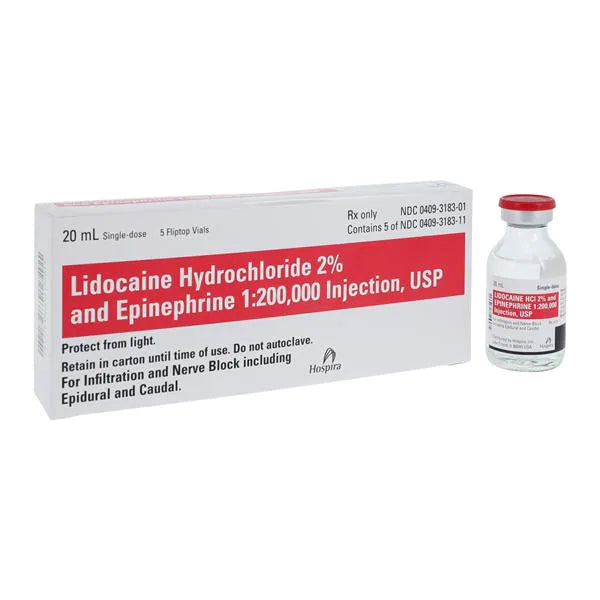Lidocaine Hydrochloride 2% and Epinephrine 1:200,000 for Injection 20mL, 5/Box
(Note: We don’t Fill Personal Prescriptions)
How to Order:
Lidocaine Hydrochloride 2% and Epinephrine 1:200,000 is used as a local anesthetic to provide pain relief and reduce bleeding during surgical and dental procedures. Lidocaine blocks nerve impulses to numb the treatment area, while epinephrine constricts blood vessels, prolonging the anesthetic effect and minimizing bleeding. This combination enhances the effectiveness of the anesthesia and improves surgical visibility by managing blood flow, making it ideal for precision-based procedures that require extended anesthesia duration.
Lidocaine Hydrochloride 2% and Epinephrine 1:200,000 Injection is a combined formulation used for local or regional anesthesia during surgical, dental, or diagnostic procedures. It contains lidocaine to provide analgesic effects and epinephrine as a vasoconstrictor to prolong the anesthetic action and minimize bleeding. This product is supplied in 20 mL vials and packaged by Pfizer Injectables in boxes containing 5 vials.
Details and Features:
Volume: 20 mL per vial
Concentration: Lidocaine Hydrochloride 2% (20 mg/mL) and Epinephrine 1:200,000 (0.005 mg/mL)
Packaging: 5 vials per box
Preservative: Multi-dose vials may have preservatives to inhibit microbial growth
Use: Local and regional anesthesia for minor surgical or medical procedures
Mechanism of Action:
Lidocaine: Works by blocking sodium ion channels in neuronal cell membranes, preventing the initiation and conduction of nerve impulses. This action provides local anesthesia, creating a loss of sensation in the area where it is applied.
Epinephrine: Acts as a vasoconstrictor, narrowing blood vessels and reducing local blood flow. This prolongs the action of lidocaine by slowing its absorption into the systemic circulation, enhances the local anesthetic effect, and minimizes bleeding in the surgical field.
Warnings:
-
Allergic Reactions: Contraindicated in patients with known allergies to lidocaine, epinephrine, or similar amide-type local anesthetics.
-
Systemic Toxicity: Risk of systemic toxicity increases with excessive dosage or accidental intravascular injection, presenting risks such as CNS disturbances or cardiovascular complications.
-
Cardiovascular Concerns: Use cautiously in patients with cardiovascular disease, hyperthyroidism, or severe hypertension due to potential exacerbation of symptoms from epinephrine.
-
Proper Administration: Ensure correct administration and avoid intravascular injection by using aspiration techniques before injection.
- Special Populations: Adjust dosage for patients with hepatic disease, cardiac impairment, or in elderly and debilitated individuals to prevent accumulation and toxicity.
Side Effects:
-
Local Reactions: Possible pain or irritation at the site of injection; rare cases of localized tissue reaction.
-
Central Nervous System Effects: Dizziness, restlessness, excitement, or if toxic levels are reached, tremors, convulsions, or CNS depression.
-
Cardiovascular Effects: Increased heart rate, palpitations, hypertension, or arrhythmias primarily due to epinephrine action.
- Allergic Reactions: Rare but can occur, leading to symptoms ranging from mild rashes to more severe anaphylactic reactions in sensitive individuals.
The use of Lidocaine Hydrochloride 2% with Epinephrine must be managed by healthcare professionals skilled in local anesthetic techniques, ensuring patient safety through proper dosing, administration, and monitoring, along with being prepared to manage potential adverse effects.

